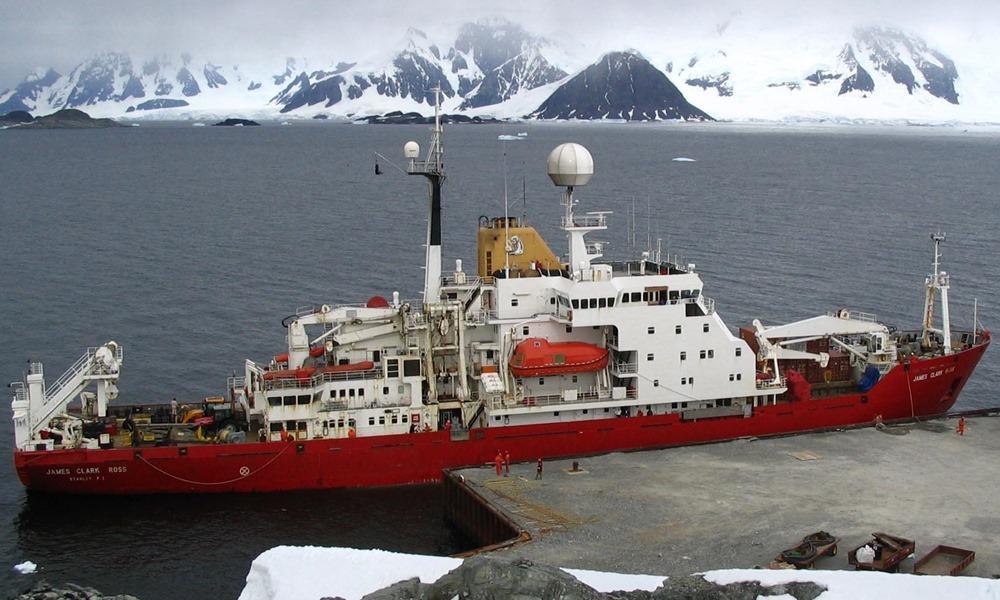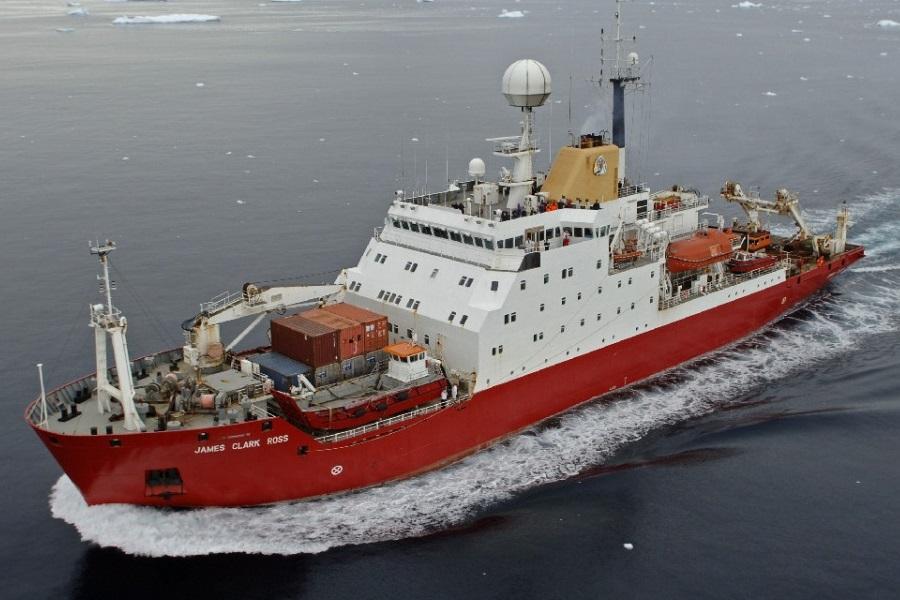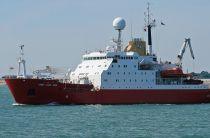Noosfera icebreaker
Former name: RRS James Clark Ross
Noosfera icebreaker current position
Noosfera icebreaker current location is at Southern Ocean (coordinates -62.15233 S / -58.49255 W) cruising en route to ARCTOWSKI ANTARCTICA. The AIS position was reported 1 hour ago.
Current PositionSpecifications of Noosfera icebreaker
| Year of build | 1991 / Age: 33 |
| Flag state | Falkland Islands |
| Builder | Swan Hunter (Wallsend, Tyne and Wear, England) |
| Class | diesel icebreaker (UK Antarctica and Arctic research ship) |
| Speed | 12 kn / 22 km/h / 14 mph |
| Length (LOA) | 99 m / 325 ft |
| Beam (width) | 19 m / 62 ft |
| Gross Tonnage | 5732 gt |
| Passengers | 50 |
| Crew | 27 |
| Decks | 6 |
| Cabins | 20 |
| Decks with cabins | 2 |
| Last Refurbishment | 2010 |
| Former names | RRS James Clark Ross |
| Christened by | HM Queen Elizabeth II (RRS James Clark Ross) |
| Owner | Ukrainean government |
| Operator | NANC-National Antarctic Scientific Center (Ukraine) |
Noosfera icebreaker Review
Review of Noosfera icebreaker
The 1991-built (as "RRS James Clark Ross") ship Noosfera was a UK icebreaking vessel used primarily as a logistics (research/survey/cargo) supply ship serving Antarctica-based scientific stations. The vessel was also open for chartering as a cruise ship on biological, oceanographic and geophysical-themed itineraries. Departures were roundtrip from Port Stanley (Falkland Islands). On Arctic expedition voyages, RRS James Clark Ross was leaving from Portsmouth England (homeported at the Naval Base). RRS stands for "Royal Research Ship".
History and ownership
In 2021, the icebreaker (IMO number 8904496) was sold to Ukraine, renamed "Noosfera" and its flag-state/registry was changed from UK-Falkland Islands (MMSI 740339000) to Ukraine (MMSI 272183900).
RRS James Clark Ross was christened by HM Queen Elizabeth II.

Royal research ships are the UK's merchant navy vessels conducting scientific research for the British Government (HMG). The list of organizations that are allowed to operate RRS vessels includes NERC (abbrev "Natural Environment Research Council"), BAS (abbrev "British Antarctic Survey") and NOC (abbrev "National Oceanography Centre"). However, a warrant from the British monarch has required a vessel to be designated as RRS.
The UK's current fleet of Royal Research Ships includes the following vessels (the year built in brackets): RRS James Clark Ross (1990), RRS James Cook (2007), RRS Discovery (2013) and RRS Sir David Attenborough (2021).

This ship was named after James Clark Ross (1800-1862) - a British Royal Navy officer and an Arctic explorer. He is best known for the Antarctic expedition (1839-1843) during which was charted a huge part of Antarctica's coastline. Also during this expedition were discovered and named Victoria Land, Mount Erebus and Mount Terror (both named after the expedition's ships), Snow Hill Island, Seymour Island, Admiralty Sound. In his honor were named Ross Sea, Ross Ice Shelf, and James Ross Island. In 1844, he was knighted by Queen Victoria (1819-1901).
The current ship-operator NANC (National Antarctic Scientific Center/НАНЦ-Національний антарктичний науковий центр) is a Ukrainian government organization (part of the country's Ministry of Education and Science) that operates the Ukrainian Antarctic station "Vernadsky Research Base" (Антарктична станція Академік Вернадський). The station is at Marina Point (not far from Kyiv Peninsula) on Galindez Island (Argentine Islands, Wilhelm Archipelago, Antarctica). The closest bases are Palmer (USA) and Yelcho (Chile). In 1996, Vernadsky Base (fka "Station F"/British research base, 1947-founded on Winter Island, 1954-moved to Galindez Island) was handed over to Ukraine.
Icebreaker vessel details
The ship features an ice-strengthened double hull, Sperry Marine Bridge System, GMDSS-SAIT radar, Satellite Picture Receiver (MSGS-30), scientific mooring winch (length 4 km / 2,48 mi), shallow UW (underwater) camera (for depths up to 500 m / 1640 ft), multibeam echo sounders (swath bathymetry), cargo cranes (forward and aft), gantry cranes (midship and aft). The vessel also provides 5 containerized labs (4 on aft deck and 1 on the forward deck).
The James Clark Ross ship has a total of 31 passenger berths in all 20 passengers' (scientific or expedition cruise) staterooms, including 15 single cabins (with Pullman beds), 4 cabins (with 4 beds each) and 1 suite (with 2 single beds).
Dedicated to sciences onboard facilities include Wet Lab, Main Lab, Rough Workshop, Scientific Workshop, Waterbottle Annex, Chemistry Lab, Preparation Lab, Biochemistry Lab, combined Microbiology-Radioactive Lab, scientific freezers.
The propulsion is diesel-electric, provided by a single-shaft (with fixed pitch propeller) plus two "White Gill" controllable Azimuth thrusters - 1 bow (10 tons thrust) and 1 stern (4 tons thrust).
- Displacement tonnage: 7767 tons (fully loaded)
- Max Draught: 6,4 m (21 ft)
- Icebreaking capacity: 2,5 m (8 ft)
- Ice-class DNV GL ICE-05
- Range: 74,000 km (46,000 mi)
- Endurance: 57 days (at 12 Kn speed)
- Capacity: 77 (50 passengers, 15 crew, 12 officers)
- Cargo capacity: 1500 m3 general cargo, 250 tonnes bulk cargo
- Diesel fuel capacity: 300 tons
The ship has one aft-located helipad but no onboard helicopter. This icebreaking vessel undergoes refit/drydock maintenance annually.
For safety reasons, passengers (scientists, cruise tourists) are not allowed in the following areas and facilities (unless specific permission has been granted): Navigation Bridge, Engine Room, all machinery spaces, galley (kitchen), engineering workshops, crew areas (cabins, Crew Mess Room, Crew Bar).
Scientific staff is accommodated on the ship in 2-, 3- and 4-berth staterooms. Each of these passenger cabins is equipped with an en-suite bathroom (shower, WC / vacuum flush toilets). Linens are changed weekly. The ship has a laundrette (passenger laundry facility with 2 washing machines and 2 tumble driers), additional to its main laundry room. Cabins shouldn't be locked while the ship is at sea (only when in port).
Among the boat's public rooms are Bar, Gym (exercise equipment), Sauna Room, Green Room (lounge with TV), hospital (resident doctor).
Note: In the case of poor AIS coverage, tracking the vessel's current location will be impossible. You can see CruiseMapper's list of all icebreakers and ice-breaking research ships in the "itinerary" section of our Icebreakers hub. All states and their fleets are listed there.


